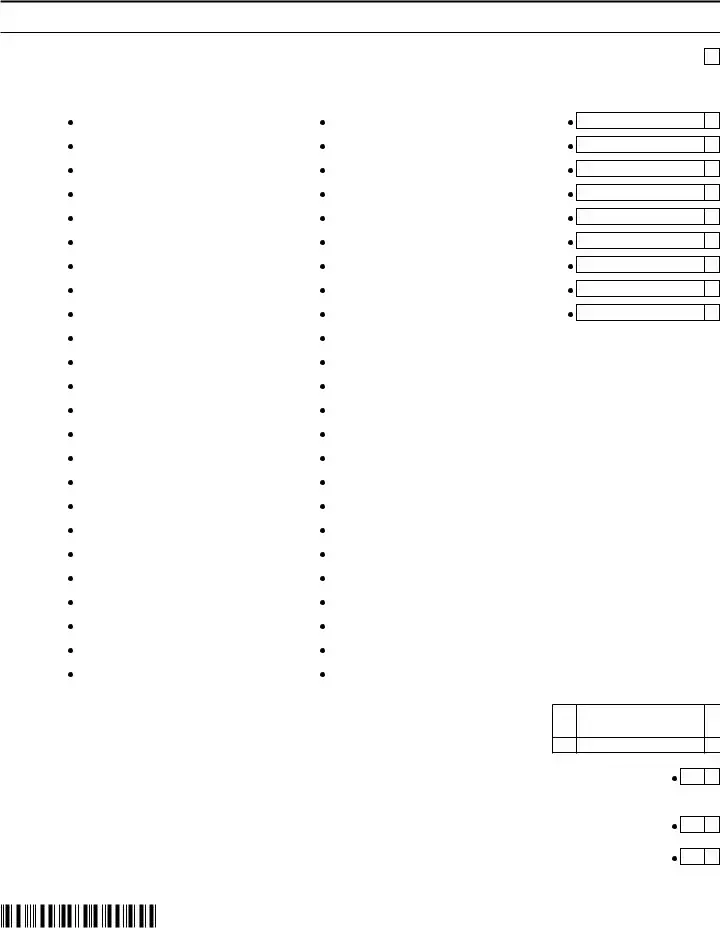Department of Taxation and Finance
General Business Corporation Franchise Tax Return
Tax Law – Article 9-A
Caution: This form must be used only for tax periods beginning on or after January 1, 2021. If you use it for any prior periods, the return will not be processed and will not be considered timely filed. As a result, penalties and interest may be incurred.
See instructions, Form CT-3-I, before completing return. |
|
|
|
All filers must enter tax period: |
|
|
|
|
|
|
|
|
|
|
|
|
|
|
|
|
Final return |
|
|
|
Amended return |
|
|
|
|
|
|
|
beginning |
|
|
|
|
|
|
ending |
|
|
|
|
|
|
|
|
|
|
|
|
|
|
|
|
|
|
|
|
|
|
|
|
|
|
|
|
|
|
|
|
|
|
|
|
|
|
|
|
|
|
|
|
|
|
|
|
|
|
|
|
|
|
Employer identification number (EIN) |
File number |
Business telephone number |
|
|
If you claim an overpayment, |
|
|
|
|
|
|
|
|
|
|
|
|
|
( |
) |
|
|
|
|
|
|
|
|
|
|
|
|
|
|
|
|
|
mark an X in the box |
|
|
|
|
|
|
|
|
|
|
|
|
|
|
|
|
|
|
|
|
|
|
|
|
|
|
|
|
|
|
|
|
|
|
|
|
|
|
|
|
|
|
|
Legal name of corporation |
|
|
|
|
|
|
|
|
Trade name/DBA |
|
|
|
|
|
|
|
|
|
|
|
|
|
|
|
|
|
|
|
|
|
|
|
|
|
|
|
|
|
|
Mailing address |
|
|
|
|
|
|
|
|
State or country of incorporation |
|
|
|
|
|
|
|
|
|
|
Care of (c/o) |
|
|
|
|
|
|
|
|
|
|
|
|
|
|
|
|
|
|
|
|
|
|
Number and street or PO box |
|
|
|
|
Date of incorporation |
|
Foreign corporations: date began business in NYS |
|
|
|
|
|
|
|
|
|
|
|
|
|
City |
U.S. state/Canadian province |
ZIP/Postal code |
|
|
Country (if not United States) |
|
For office use only |
|
|
|
|
|
|
|
|
|
|
|
|
|
|
|
|
|
|
|
Principal business activity in NYS |
|
|
NAICS business code number (from NYS Pub 910) |
|
|
|
|
|
|
|
|
|
|
|
|
|
|
|
|
|
|
|
|
|
|
|
|
|
|
|
|
|
|
|
|
|
|
|
|
|
|
|
|
|
|
|
|
|
|
|
|
|
|
If you need to update your address or phone information for corporation tax, or other tax types, you can do so online. |
|
|
|
|
|
|
|
|
|
|
See Business information in Form CT-1. |
|
|
|
|
|
|
|
|
|
|
|
|
|
|
|
|
|
|
|
|
|
|
|
|
|
|
|
|
|
|
|
|
|
|
|
|
|
|
|
|
|
|
|
|
|
|
|
|
|
|
|
|
|
|
|
A. Pay amount shown on Part 2, line 19c. Make payable to: New York State Corporation Tax |
|
|
|
Payment enclosed |
|
|
Attach your payment here. (Detach all check stubs; see instructions for details.) |
|
|
|
|
|
A |
|
|
|
|
|
|
|
B. Are you subject to the metropolitan transportation business tax (MTA surcharge)? (see instructions;
mark an X in the appropriate box ) ..................................................................................................................
C.If you are disclaiming tax liability in New York State based on Public Law 86-272, mark an X
in the box (see instructions) |
C |
|
D.Do you have an interest in any partnerships? (mark an X in the appropriate box) ............................................
If Yes, enter the name(s) and EIN(s) on Form CT-60 and attach it to your return.
Yes 

No 

Third – party |
Yes |
No |
Designee’s name (print) |
Designee’s phone number |
|
( |
) |
|
designee |
|
|
|
|
|
|
Designee’s email address |
|
|
|
(see instructions) |
|
PIN |
|
Certification: I certify that this return and any attachments are to the best of my knowledge and belief true, correct, and complete.
Authorized |
Printed name of authorized person |
|
Signature of authorized person |
|
Official title |
|
person |
Email address of authorized person |
|
|
|
Telephone number |
|
|
Date |
|
|
|
|
|
( |
) |
|
|
|
|
|
|
Paid |
Firm’s name (or yours if self-employed) |
|
|
Firm’s |
EIN |
|
|
|
|
Preparer’s PTIN or SSN |
preparer |
|
|
|
|
|
|
|
|
|
|
|
|
use |
Signature of individual preparing this return |
Address |
City |
|
State |
ZIP code |
|
|
|
|
|
|
|
|
|
|
|
|
only |
|
|
|
|
|
|
|
|
Email address of individual preparing this return |
|
|
Preparer’s NYTPRIN or |
Excl. code |
Date |
|
(see instr.) |
|
|
|
|
|
|
|
|
|
|
|
|
|
|
|
|
|
|
|
|
|
|
|
|
See instructions for where to file.
Content of Form CT-3
Part 1 |
– General corporate information |
Part 5 |
– Computation of investment capital for the current tax year |
Part 2 |
– Computation of balance due or overpayment |
Part 6 |
– Computation of business apportionment factor |
Part 3 |
– Computation of tax on business income base |
Part 7 |
– Summary of tax credits claimed |
Part 4 |
– Computation of tax on capital base |
|
|
Failure to meet investment capital holding period
Page 2 of 8 CT-3 (2021)
Part 1 – General corporate information
Section A – Qualification for preferential tax rates – If you are a corporation as identified in this section and qualify for preferential tax rates, mark an X in the boxes that apply to you (see instructions).
1A qualified emerging technology company (QETC) eligible for the lower business income base tax rate, 0% capital
base tax rate, and lower fixed dollar minimum tax amounts |
1 |
2A qualified New York manufacturer based on the principally engaged test eligible for the 0% business income
base tax rate and lower fixed dollar minimum tax amounts |
2 |
3A qualified New York manufacturer based on the principally engaged test eligible for the 0% capital base
4A qualified New York manufacturer based on the significant employment and property test eligible for the 0% business
|
|
income base tax rate, 0% capital base tax rate, and lower fixed dollar minimum tax amounts |
4 |
5 |
A cooperative housing corporation eligible for the 0% capital base tax rate |
5 |
6 |
A small business taxpayer eligible for the 0% capital base tax rate |
6 |
|
|
If you marked this box, complete line 6a below and Section B, line 1. |
|
..........................................................................................................6a Total capital contributions |
6a |
7A qualified entity of a New York State innovation hot spot that operates solely within such New York State innovation
|
hot spot, and you have elected to be subject only to the fixed dollar minimum tax base |
7 |
Section B – New York State information (see instructions) |
|
1 |
Number of New York State employees |
1 |
2 |
Wages paid to New York State employees |
2 |
3 |
Number of business establishments in New York State |
3 |
4 |
If you have an interest in, or have rented, real property in New York State, mark an X in the box |
4 |
5If you are claiming an exception to the related member expense addback under Tax Law §208.9(o)(2)(B),
mark an X in the box |
5 |
5a If you marked the line 5 box, use line 5a to report the applicable exception |
Number |
Amount |
number (1-4) and the amount of royalty payments |
5a |
|
6If you are not protected by Public Law 86-272 and are subject to tax solely as a result of deriving receipts in
New York State, mark an X in the box |
6 |
Section C – Filing information
1Federal return filed – you must mark an X in one box and attach a complete copy of your federal return
|
|
1120-REIT |
|
|
|
|
1120 |
1120 consolidated |
or 1120-RIC |
|
|
1120S |
1120F |
|
2Amended return – If you marked the amended return box on page 1, then for any item(s) that apply, mark an X in the box
and attach documentation:
Final federal |
Date of determination |
NOL |
Capital loss |
|
|
determination |
|
|
carryback |
carryback.... |
1139 |
1120X |
2a Enter the tax due amount from your most recently filed New York State return for this tax period . 
 2a
2a
3Required attachments – For all forms, other than tax credit claim forms, that are attached to this return, mark an X in the applicable box(es)
4If you are claiming tax credits, enter the number of tax credit forms attached to this return. Where multiple forms
are filed for the same credit, count each form filed. |
4 |
5 If you filed federal Form 1120F and you have effectively connected income (ECI), mark an X in the box |
5 |
6Were you required to report any nonqualified deferred compensation, as required by Internal Revenue
Code (IRC) §457A, on your 2021 federal return? (see instructions) |
Yes |
No |
7If you are a foreign corporation computing your tax taking into account only your distributive shares from multiple limited
partnerships, mark an X in the box and file Form CT-60 ........................................................................................................ 

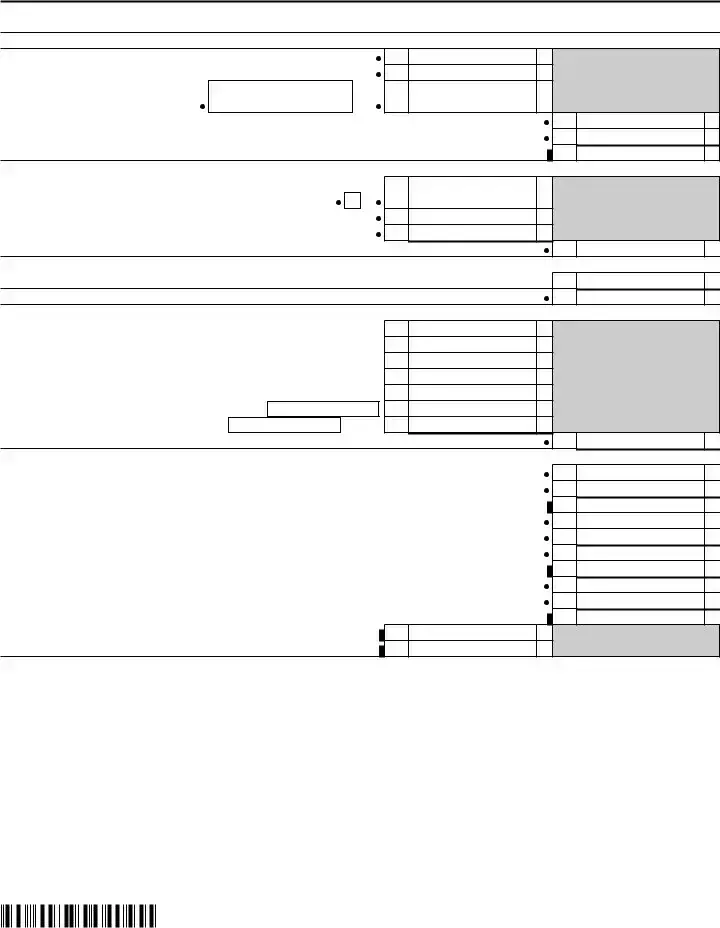
CT-3 (2021) Page 3 of 8
Part 2 – Computation of balance due or overpayment |
|
Largest of three tax bases, minus credits |
|
|
1a |
Business income base tax (from Part 3, line 20) |
1a |
|
1b |
Capital base tax (from Part 4, line 15; see instructions) |
1b |
|
|
New York receipts |
|
|
1c |
Fixed dollar minimum tax (see instr) |
..... 1c |
|
2 |
Tax due (enter the amount from line 1a, 1b, or 1c, whichever is largest; see instructions) |
2 |
3 |
Tax credits used (from Part 7, line 2; see instructions) |
3 |
4 |
Tax due after credits (subtract line 3 from line 2; if line 3 is more than line 2, enter 0) |
4 |
Penalties and interest |
|
|
5Estimated tax penalty (see instructions; if Form CT-222 is
|
attached, mark an X in the box) |
5 |
6 |
Interest on late payment (see instructions) |
6 |
7 |
Late filing and late payment penalties (see instructions) |
7 |
8 |
Total penalties and interest (add lines 5, 6, and 7) |
8 |
Voluntary gifts/contributions |
|
9 |
Total voluntary gifts/contributions (from Form CT-227, Part 2, line 1) |
9 |
10 |
Total amount due (add lines 4, 8, and 9) |
10 |
Prepayments |
|
11 |
Mandatory first installment from Form CT-300 (see instructions) |
11 |
12 |
Second installment (from Form CT-400) |
12 |
13 |
Third installment (from Form CT-400) |
13 |
14 |
Fourth installment (from Form CT-400) |
14 |
15 |
Payment with extension request (from Form CT-5, line 5) |
15 |
16 |
Overpayment credited from prior years (see instr.) Period |
16 |
17 |
Overpayment credited from CT-3-M Period |
17 |
18 |
Total prepayments (add lines 11 through 17; see instructions) |
18 |
Payment due or overpayment to be credited/refunded (see instructions) |
|
19a |
Underpayment |
19a |
19b |
Additional amount for 2022 MFI |
19b |
19c |
Balance due |
19c |
20a |
Excess prepayments |
20a |
20b |
Amount previously credited to 2022 MFI |
20b |
20c |
Overpayment |
20c |
21 |
Amount of overpayment to be credited to next period |
21 |
22 |
Balance of overpayment available (subtract line 21 from line 20c) |
22 |
23 |
Amount of overpayment to be credited to Form CT-3-M |
23 |
24 |
Balance of overpayment to be refunded (subtract line 23 from line 22) |
24 |
25 |
Unused tax credits to be refunded |
25 |
26 |
Unused tax credits applied to next period |
26 |

Page 4 of 8 CT-3 (2021) |
|
Part 3 – Computation of tax on business income base |
|
1 |
Federal taxable income (FTI) before net operating loss (NOL) and special deductions (see instructions). |
1 |
2 |
Additions to FTI (from Form CT-225, line 5) |
2 |
3 |
Add lines 1 and 2 |
3 |
4 |
Subtractions from FTI (from Form CT-225, line 10) |
4 |
5 |
Subtract line 4 from line 3 |
5 |
6 |
Subtraction modification for qualified banks (from Form CT-3.2, Schedule A, line 1; see instructions) .... |
6 |
7 |
Entire net income (ENI) (subtract line 6 from line 5) |
7 |
8 |
Investment and other exempt income (from Form CT-3.1, Schedule D, line 1) |
8 |
9 |
Subtract line 8 from line 7 |
9 |
10Excess interest deductions attributable to investment income, investment capital, and other
exempt income (from Form CT-3.1, Schedule D, line 2) |
10 |
11 Business income (add lines 9 and 10) |
11 |
12Addback of income previously reported as investment income (from Form CT-3.1, Schedule F,
|
line 6; if zero, enter 0; see instructions) |
12 |
13 |
Business income after addback (add lines 11 and 12) |
13 |
14 |
Business apportionment factor (from Part 6, line 56) |
14 |
15 |
Apportioned business income after addback (multiply line 13 by line 14) |
15 |
16 |
Prior net operating loss conversion subtraction (from Form CT-3.3, Schedule C, line 4) |
16 |
17 |
Subtract line 16 from line 15 |
17 |
18 |
NOL deduction (from Form CT-3.4, line 6) |
18 |
19 |
Business income base (subtract line 18 from line 17) |
19 |
20Business income base tax (multiply line 19 by the appropriate business income tax rate from the tax
rates schedule in Form CT-3-I; enter here and on Part 2, line 1a; see instructions) |
20 |
Note: If you make any entry on line 2, 4, 6, 8, 10, 12, 16, or 18, you must complete and file the appropriate attachment form, or any tax benefit claimed may be disallowed, or there may be a delay in receiving such benefit. In addition, all amounts entered on these lines must be entered as positive numbers.
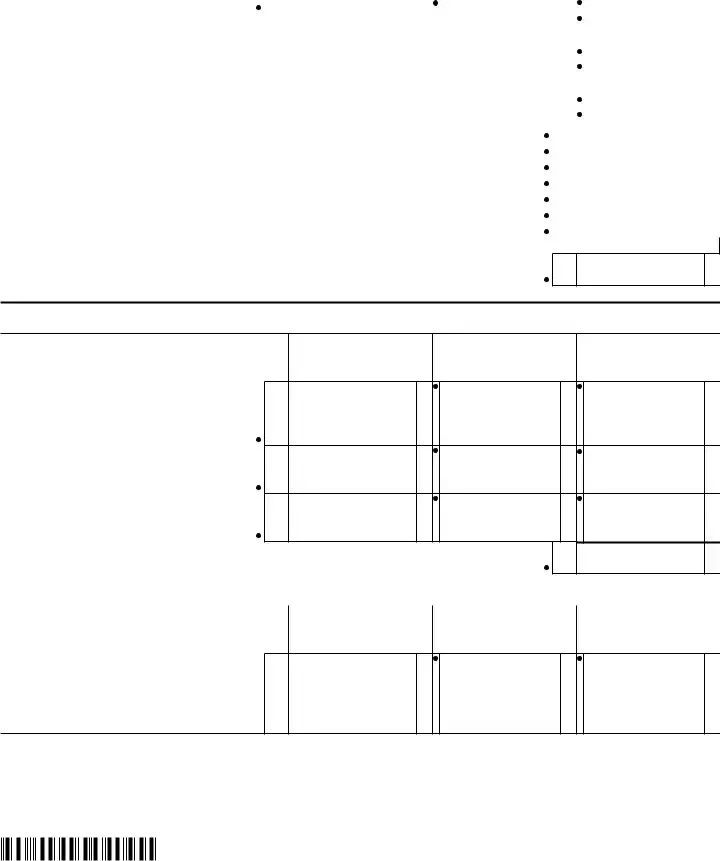
|
|
|
|
|
|
|
|
|
|
CT-3 (2021) Page 5 of 8 |
|
|
|
|
|
|
|
|
Part 4 – Computation of tax on capital base (see instructions) |
|
|
|
|
|
|
|
|
|
|
|
|
|
|
|
|
|
|
|
|
|
|
|
|
A |
|
|
B |
|
|
C |
|
|
|
Beginning of year |
|
|
End of year |
|
|
Average value |
1 |
Total assets from federal return |
1 |
|
|
|
|
|
|
|
|
|
|
|
2 |
Real property and marketable securities |
|
|
|
|
|
|
|
|
|
|
|
|
3 |
included on line 1 |
2 |
|
|
|
|
|
|
|
|
|
|
|
.........................Subtract line 2 from line 1 |
3 |
|
|
|
|
|
|
|
|
|
|
|
4 |
Real property and marketable securities |
4 |
|
|
|
|
|
|
|
|
|
|
|
5 |
at fair market value |
|
|
|
|
|
|
|
|
|
|
|
.......Adjusted total assets (add lines 3 and 4) |
5 |
|
|
|
|
|
|
|
|
|
|
|
6 |
Total liabilities |
6 |
|
|
|
|
|
|
|
|
|
|
|
7 |
.........................................................Total net assets (subtract line 6, column C, from line 5, column C) |
|
7 |
|
|
|
|
8 |
............................................................Investment capital (from Part 5, line 19; if zero or less, enter 0) |
|
8 |
|
|
|
|
9 |
.......................................................................................Business capital (subtract line 8 from line 7) |
|
|
|
|
|
|
|
9 |
|
|
|
|
10 |
Addback of capital previously reported as investment capital (from Part 5, line 20, column C; if zero or less, enter 0) . |
|
10 |
|
|
|
|
11 |
.........................................................................................Total business capital (add lines 9 and 10) |
|
|
|
|
|
|
|
11 |
|
|
|
|
12 |
.........................................................................Business apportionment factor (from Part 6, line 56) |
|
12 |
|
|
|
|
13 |
...................................................................Apportioned business capital (multiply line 11 by line 12) |
|
13 |
|
|
|
|
14 |
|
|
|
|
|
|
|
|
|
|
|
|
|
15Capital base tax (multiply line 13 by the appropriate capital base tax rate from the tax rates schedule in
Form CT-3-I; enter here and on Part 2, line 1b) |
15 |
Part 5 – Computation of investment capital for the current tax year (see instructions) |
A |
B |
C |
Average fair |
Liabilities attributable to |
Net average value |
market value |
column A amount |
(column A - column B) |
16 Total capital that generates income
claimed to not be taxable by New York
under the U.S. Constitution
(from Form CT-3.1, Schedule E, line 1) |
16 |
17 Total of stocks actually held for more than |
|
one year (from Form CT-3.1, Schedule E,
line 2) |
17 |
18 Total of stocks presumed held for more |
|
than one year (from Form CT-3.1,
19Total investment capital for the current year (Add column C lines 16, 17, and 18; enter the result here
and on Part 4, line 8. If zero or less, enter 0.) |
19 |
Addback of capital previously reported as investment capital
20Total of stocks previously presumed held
for more than one year, but did not meet
the holding period (from Form CT-3.1,
Schedule F, line 1; enter here and on
Part 4, line 10)........................................... 
A |
B |
C |
Average fair market |
Liabilities attributable |
Net average value as |
value as previously reported |
to column A amount as |
previously reported |
|
previously reported |
(column A - column B) |
20
Page 6 of 8 CT-3 (2021)
Part 6 – Computation of business apportionment factor (see instructions)
Mark an X in this box only if you have no receipts required to be included in the denominator of the apportionment factor (see instr.) ... 

A – New York State |
B – Everywhere |
Section 210-A.2 |
|
1 |
Sales of tangible personal property |
1 |
2 |
Sales of electricity |
2 |
3 |
Net gains from sales of real property |
3 |
Section 210-A.3 |
|
4 |
Rentals of real and tangible personal property |
4 |
5 |
Royalties from patents, copyrights, trademarks, and similar intangible |
|
|
personal property |
5 |
6 |
Sales of rights for certain closed-circuit and cable TV transmissions |
|
|
of an event |
6 |
Section 210-A.4 |
|
7 |
Sale, licensing, or granting access to digital products |
7 |
Section 210-A.5(a)(1) – Fixed percentage method for qualified financial instruments (QFIs)
8 To make this irrevocable election, mark an X in the box (see instructions) |
8 |
Section 210-A.5(a)(2) – Mark an X in each box that is applicable (see line 8 instructions)
Section 210-A.5(a)(2)(A) |
|
|
9 |
Interest from loans secured by real property |
|
|
10 |
Net gains from sales of loans secured by real property |
|
|
11 |
Interest from loans not secured by real property (QFI |
|
.............. ) |
12Net gains from sales of loans not secured by real property (QFI 
 ).
). 
Section 210-A.5(a)(2)(B) (QFI 
 )
)
13 |
Interest from federal debt |
14 |
|
|
15 |
Interest from NYS and its political subdivisions debt |
16 |
Net gains from federal, NYS, and NYS political subdivisions debt |
17 |
Interest from other states and their political subdivisions debt |
18 |
Net gains from other states and their political subdivisions debt |
Section 210-A.5(a)(2)(C) (QFI |
) |
19Interest from asset-backed securities and other government agency debt. 
20Net gains from government agency debt or asset-backed securities
|
|
|
21 |
sold through an exchange |
Net gains from all other asset-backed securities |
Section 210-A.5(a)(2)(D) (QFI |
) |
22 |
Interest from corporate bonds |
23Net gains from corporate bonds sold through broker/dealer or
licensed exchange ............................................................................ 
24 Net gains from other corporate bonds ................................................. 
Section 210-A.5(a)(2)(E)
25Net interest from reverse repurchase and securities borrowing agreements.
Section 210-A.5(a)(2)(F)
26 |
Net interest from federal funds |
Section 210-A.5(a)(2)(I) (QFI |
) |
27 |
Net income from sales of physical commodities |
Section 210-A.5(a)(2)(J) (QFI |
) |
28 |
Marked to market net gains |
Section 210-A.5(a)(2)(H) (QFI |
) |
29 |
210-A.5(a)(2)(G) (QFI |
) |
Interest from other financial instruments |
30 |
Net gains and other income from other financial instruments |
9
10
11
12
13
15
16
17
18
19
20
21
22
23
24
25
26
27
28
29
30

CT-3 (2021) Page 7 of 8
Part 6 – Computation of business apportionment factor (continued)
A – New York State |
B – Everywhere |
Section 210-A.5(b) |
|
|
|
|
|
31 |
Brokerage commissions |
31 |
|
|
|
|
32 |
Margin interest earned on behalf of brokerage accounts |
32 |
|
|
|
|
33 |
Fees for advisory services for underwriting or management of underwriting . |
33 |
|
|
|
|
34 |
Receipts from primary spread of selling concessions |
34 |
|
|
|
|
35 |
Receipts from account maintenance fees |
35 |
|
|
|
|
36 |
Fees for management or advisory services |
36 |
|
|
|
|
37 |
...................................................Interest from an affiliated corporation |
37 |
|
|
|
|
Section 210-A.5(c) |
|
|
|
|
|
38 |
Interest, fees, and penalties from credit cards |
38 |
|
|
|
|
39 |
Service charges and fees from credit cards |
39 |
|
|
|
|
40 |
Receipts from merchant discounts |
40 |
|
|
|
|
41 |
Receipts from credit card authorizations and settlement processing ... |
41 |
|
|
|
|
42 |
..................................................Other credit card processing receipts |
42 |
|
|
|
|
Section 210-A.5(d) |
|
|
|
|
|
43 |
Receipts from certain services to investment companies |
43 |
|
|
|
|
Section 210-A.5-a |
|
|
|
|
|
44 |
Global intangible low-taxed income |
44 |
0 |
00 |
|
|
Section 210-A.6 |
|
|
|
|
|
45 |
Receipts from railroad and trucking business |
45 |
|
|
|
|
Section 210-A.6-a |
|
|
|
|
|
46 |
Receipts from the operation of vessels |
46 |
|
|
|
|
Section 210-A.7 |
|
|
|
|
|
47 |
Receipts from air freight forwarding |
47 |
|
|
|
|
48 |
..................................................Receipts from other aviation services |
48 |
|
|
|
|
Section 210-A.8 |
|
|
|
|
|
49 |
Advertising in newspapers or periodicals |
49 |
|
|
|
|
50 |
.........................................................Advertising on television or radio |
50 |
|
|
|
|
51 |
.................................................................Advertising via other means |
51 |
|
|
|
|
Section 210-A.9 |
|
|
|
|
|
52 |
Transportation or transmission of gas through pipes |
52 |
|
|
|
|
Section 210-A.10 |
|
|
|
|
|
53 |
Receipts from other services/activities not specified |
53 |
|
|
|
|
Section 210-A.11 |
|
|
|
|
|
54 |
Discretionary adjustments |
54 |
|
|
|
|
Total receipts |
|
|
|
|
|
55 |
Add lines 1 through 54 in columns A and B |
55 |
|
|
|
|
Calculation of business apportionment factor |
|
|
|
|
|
56New York State business apportionment factor (divide line 55, column A by line 55, column B and enter the
resulting decimal here; round to the sixth decimal place after the decimal point; see instructions) |
56 |
Enter line 56 on Part 3, Computation of tax on business income base, line 14; and on Part 4, Computation of tax on capital base, line 12.
Page 8 of 8 CT-3 (2021)
Part 7 – Summary of tax credits claimed
1Have you been convicted of an offense, or are you an owner of an entity convicted of an offense, defined in New York State
Penal Law, Article 200 or 496, or section 195.20? (see Form CT-1; mark an X in one box) |
1 |
Yes |
|
|
No |
|
|
|
|
|
|
|
|
Enter in the appropriate box below the amount of each tax credit used to reduce the tax due shown on Part 2, line 2, and attach the corresponding properly completed claim form. The amount of credit to enter is computed on each credit form and carried to this section.
CT-37 |
|
|
CT-607 |
|
|
CT-651 |
CT-40 |
|
|
CT-611 |
|
|
CT-652 |
|
|
|
|
CT-41 |
|
|
CT-611.1 |
|
|
CT-654 |
|
|
|
|
CT-43 |
|
|
CT-611.2 |
|
|
CT-655 |
|
|
|
|
CT-44 |
|
|
CT-612 |
|
|
DTF-621 |
|
|
|
|
CT-46 |
|
|
CT-613 |
|
|
DTF-622 |
|
|
|
|
CT-47 |
|
|
CT-631 |
|
|
DTF-624 |
|
|
|
|
CT-236 |
|
|
CT-633 |
|
|
DTF-630 |
|
|
|
|
CT-238 |
|
|
CT-634 |
|
|
Other credits |
|
|
|
|
CT-239 |
|
|
CT-635 |
|
|
|
|
|
|
|
|
CT-241 |
|
|
CT-636 |
|
|
|
|
|
|
|
|
CT-242 |
|
|
CT-637 |
|
|
|
|
|
|
|
|
CT-246 |
|
|
CT-638 |
|
|
|
|
|
|
|
|
CT-248 |
|
|
CT-640 |
|
|
|
|
|
|
|
|
CT-249 |
|
|
CT-641 |
|
|
|
|
|
|
|
|
CT-250 |
|
|
CT-642 |
|
|
|
|
|
|
|
|
CT-261 |
|
|
CT-643 |
|
|
|
|
|
|
|
|
CT-501 |
|
|
CT-644 |
|
|
|
|
|
|
|
|
CT-601 |
|
|
CT-645 |
|
|
|
|
|
|
|
|
CT-602 |
|
|
CT-646 |
|
|
|
|
|
|
|
|
CT-603 |
|
|
CT-647 |
|
|
|
|
|
|
|
|
CT-604 |
|
|
CT-648 |
|
|
|
|
|
|
|
|
CT-605 |
|
|
CT-649 |
|
|
|
|
|
|
|
|
CT-606 |
|
|
CT-650 |
|
|
|
|
|
|
|
|
2Total tax credits claimed above (enter here and on Part 2, line 3; attach appropriate form for each credit
claimed) ......................................................................................................................................... 
3Total tax credits claimed that are refund eligible (see instructions) .................................................... 
4a If you claimed the QEZE tax reduction credit and you had a 100% zone allocation factor, mark an X in the box ................
4b If you claimed the tax-free NY area tax elimination credit, and you had a 100% area allocation factor, mark an X
in the box ...........................................................................................................................................................................
4c If you claimed the tax-free NY area excise tax on telecommunications credit and you had a 100% area allocation
factor, mark an X in the box ...............................................................................................................................................
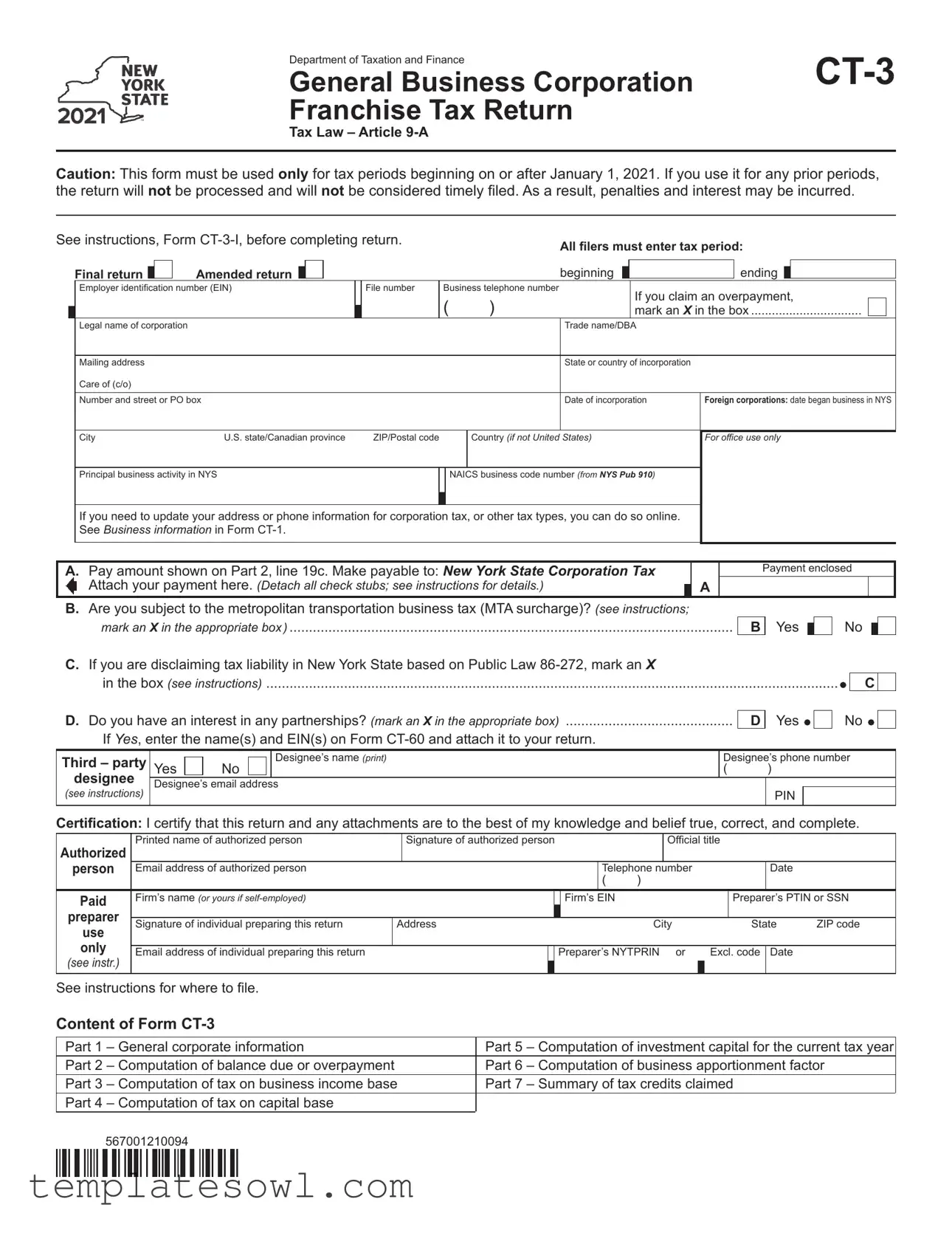





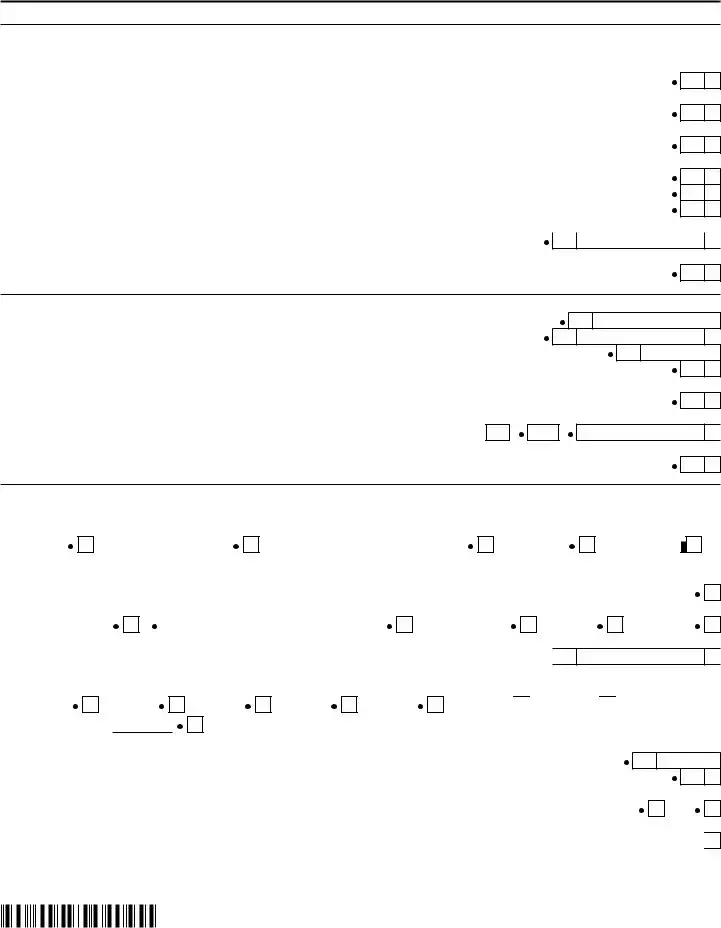

















 ).
). 







